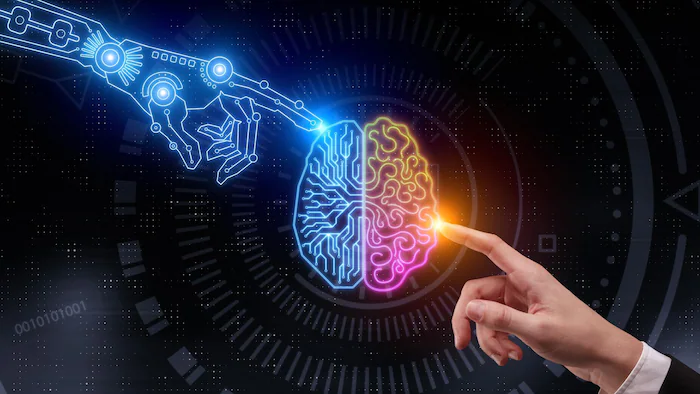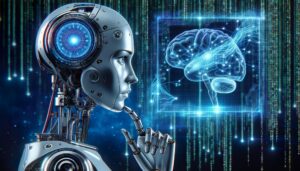Table of contents
ToggleIntroduction
By 2030, 375 million workers may need to change jobs due to AI. Should we be worried or excited?
This statistic, from a McKinsey report, alone illustrates the scale of the upcoming transformation. Artificial intelligence is no longer an emerging technology confined to research labs—it’s now present in our offices, factories, stores, and even the most skilled professions. Task automation, virtual assistants, decision-making algorithms… AI is reshaping the professional world at an unprecedented speed.
In light of this technological revolution, one key question divides opinions: will AI destroy jobs or create more of them? Is it a threat to job market stability or an opportunity to rethink the human value at the heart of our professions?
In this article, we will explore both sides of this transformation: the concrete risks for certain traditional jobs, the opportunities for creation and adaptation, and the necessary conditions to make this evolution inclusive and beneficial for all.
1. A Real Threat to Certain Traditional Jobs
While artificial intelligence opens up many possibilities, it also poses a direct threat to numerous jobs, especially those involving repetitive, standardized, or easily modelled tasks. This revolution is not in the future—it’s already happening in many sectors.
A. Automation of Repetitive Tasks
One of the first visible effects of AI is the automation of simple and repetitive tasks. Software with learning algorithms can now process data, handle customer queries, or perform basic functions without human intervention.
Jobs such as cashiers, call center agents, or data entry clerks are already being partially replaced by AI solutions like chatbots, self-checkout machines, or RPA (Robotic Process Automation). For businesses, the benefit is threefold: reduced costs, continuous availability, and fewer errors.
B. Gradual Disappearance of Low-Skilled Jobs
Low-skilled jobs are the most vulnerable to this wave of automation. Sectors such as logistics, handling, or certain administrative services are already undergoing radical transformation.
For example, in Amazon warehouses, Kiva robots move product shelves instead of human pickers. This kind of technology questions the sustainability of millions of jobs worldwide, particularly in developing countries where such positions are abundant.
This accentuates the polarization of the labor market: highly skilled jobs thrive, low-skilled jobs vanish, and middle-skill jobs become scarce.
C. A Growing Skills Mismatch
Beyond outright job cuts, AI accelerates the obsolescence of certain skills. More and more workers find themselves out of sync with market demands. Companies now seek profiles capable of interacting with advanced digital tools, understanding algorithms, or interpreting data.
However, this transition requires time and massive training initiatives, which many countries have yet to implement. This gap between available and required skills could become a major barrier to digital transformation, leading to exclusion, long-term unemployment, and social tensions.
2. An Opportunity for Transformation and Creation of New Jobs
While AI replaces certain jobs, it also creates new ones, sometimes in sectors that barely existed a few years ago. The history of industrial revolutions teaches us: every wave of innovation destroys jobs but also generates others—often more skilled, more productive, and richer in added value. The key is to anticipate and prepare for these changes.
A. Emergence of New AI-Related Jobs
The rise of artificial intelligence has triggered an explosion in demand for specialized profiles. Jobs such as data scientist, machine learning engineer, or AI ethicist are now essential to modern business operations.
Additionally, new roles are emerging to support AI, such as “prompt engineers,” responsible for designing optimal interactions between humans and generative AI.
According to the World Economic Forum, AI could create 97 million new jobs by 2025, more than compensating for losses in some traditional sectors.
B. Complementarity Between Humans and Machines
Contrary to popular belief, AI does not always aim to replace humans. Instead, it can become a powerful efficiency tool. In sectors like healthcare, finance, or marketing, AI assists professionals in data analysis, decision-making, or service personalization.
Doctors remain central to patient relationships but benefit from technological support to make diagnoses.
In this new paradigm, human skills such as creativity, critical thinking, communication, and emotional intelligence become even more valuable. These are the qualities that make the difference compared to machines.
C. New Forms of Employment and Work Organization
AI also drives the transformation of work organization models. Automating certain tasks frees up time for higher value-added missions, encouraging hybrid models: remote work, freelancing, project-based work, or even fully virtual companies.
This brings increased flexibility and better work-life balance for some, but also risks precariousness for others if these new statuses lack adequate social protections.
Meanwhile, AI-powered digital platforms (like Upwork, Fiverr, or Malt) are reshaping the relationship between workers and businesses, opening up new income opportunities worldwide.
3. Adapting Society to Make AI an Inclusive Opportunity
The impact of artificial intelligence on employment is not inevitable: it will depend on collective decisions made by governments, businesses, and citizens. To ensure this technological transition becomes a force for progress for all, we must implement mechanisms for adaptation, training, and regulation tailored to today’s challenges.
A. Reforming Education and Lifelong Learning
AI profoundly changes the skills sought in the labor market. Rethinking education systems to prepare younger generations for this new world is crucial. This involves:
Teaching digital skills from early schooling;
Developing soft skills such as critical thinking, collaboration, and creativity;
Incorporating AI, programming, and data management basics into curricula.
Beyond school, lifelong learning becomes essential. Workers must be able to upskill throughout their careers, particularly through accessible tools (MOOCs, micro-certifications, funded retraining programs). Without this, the risk of massive exclusion is real.
B. Implementing Proactive Public Policies
Governments have a key role to play in supporting this transition and preventing AI from further deepening social inequalities. Possible measures include:
Safety nets for affected workers (allowances, retraining programs);
Tax incentives for training and responsible innovation;
Massive investments in digital infrastructure.
Furthermore, governments must commit to regulating AI use ethically: protecting privacy, combating algorithmic bias, and ensuring transparency in automated decisions.
C. Holding Companies Accountable in the Transition
Companies must not adopt AI solely for profitability gains; they also have a social responsibility in how they integrate it. This involves:
Transparency about AI’s impact on employment;
Efforts to upskill internal staff rather than abrupt replacements;
Adopting digital ethics principles, such as explainable AI, algorithmic non-discrimination, and GDPR compliance.
Some pioneering companies are already setting examples: investing in ethical AI labs, establishing AI ethics committees, or partnering with academic institutions for more responsible AI development.
Conclusion
Artificial intelligence represents a historic turning point for the world of work. While some jobs are threatened, others are emerging—more skilled, more creative, and sometimes even more human. AI is not a fatality; it is a tool whose effects depend on the political, economic, and social choices we make today.
Massive job loss or an extraordinary lever for transformation? The answer depends on our collective ability to train, support, and regulate. Rather than fearing replacement, we should imagine complementarity between humans and machines and make AI a driver of shared progress.
Thus, the real question is not “Will AI kill jobs?” but rather: Are we ready to evolve the way we work so that AI benefits everyone?





